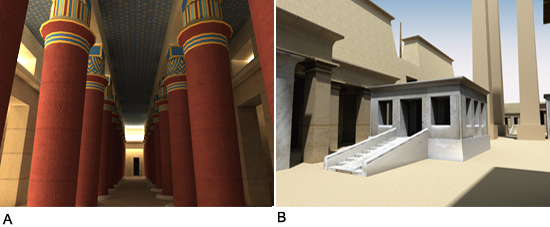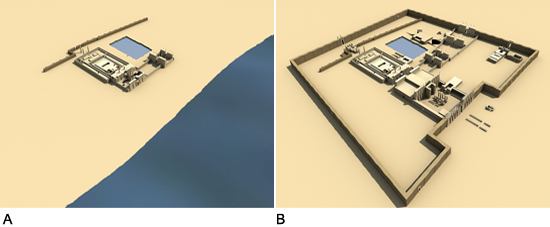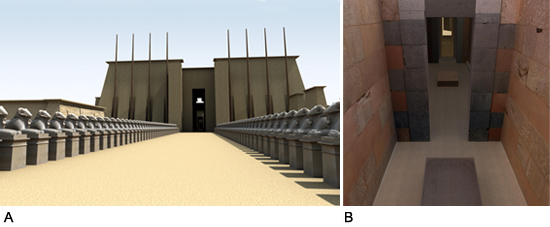|
3DVisA Resources
3DVisA Index of 3D Projects: Archaeology
Digital Karnak Project
Keywords: Karnak, Thebes, Ancient Egypt, Virtual Reality, VRML.
The colossal site of Karnak is one of the largest temple complexes in the world. Its rich architectural, ritual, religious, economic, social and political history has no parallel. The
Amun-Ra precinct, which includes a great number of individual temples, shrines
and processional ways, stands as a micro-cosmos of ancient Egypt.

Fig. 1. A. Interior of the visualisation of the Akhmenu temple of Thutmose III (18th
Dynasty). B. View of the visualisation of the 'white chapel' of Senwosret I (12th Dynasty). © UCLA. Reproduced with kind permission.
The Digital Karnak Project, run by the
University of California at Los Angeles (UCLA) aims to make the site of Karnak more accessible to students
and instructors in the English-speaking world. The features of the project website have
been designed to provide college classrooms (and the interested public) with easily
accessible, up-to-date, expert material relating to the temple precinct. As part of this goal,
a 3D Virtual Reality model of the site was constructed, offering students a
way to view the temple: reign-by-reign, following the complex patterns
of royal construction, modification, and destruction that are now obscured by the more recent
building activities. Footage of this model, as well as original videos and maps, are
accompanied by thematic essays written and reviewed by Egyptologists. This material supplies
students and instructors with reliable information in a digital and visually dynamic
format. A simplified version of the Virtual Reality model of the temple is also made
available in Google Earth, for an interactive experience.

Fig. 2. A. Bird's-eye view of the visualisation of the temple of Amun-Ra in the reign of
Thutmose IV (18th Dynasty). B. Bird's-eye view of the visualisation of the temple of Amun-Ra in the Greco-Roman period. © UCLA. Reproduced with kind permission.
The Karnak visualisation was designed using Multi-Gen Creator 3.4, a program designed
for real-time 3D modelling. The model was viewed and presented in Virtual Reality
Navigator (vrNav) 2, version 7.13. After its completion, the model was exported to two
common modelling programs, 3D Studio Max and Maya, where the video animations
and still frame images were produced. The model was also converted, decimated, and
exported to Google Earth for view on the world wide web.

Fig. 3. A. Visualisation of the possible location of the sphinx statues at the temple's
western gateway during the tenure of the 'High Priest of Amun' Pinedjem (21st Dynasty). B. Interior of the visualisation of the 'red chapel' of Hatshepsut (18th Dynasty). © UCLA. Reproduced with kind permission.
Project dates: 2006-2008
Resource status: The visualisation of the Karnak Temple is a free educational resource available on the
project website. The website has QuickTime
video footage of the visualisation, as well as a Google Earth version of the model. The
project hopes to make access to the high-resolution version of the model available to
scholars on its website in 2009.
Contributors: A team of noted Egyptologists, educators, architects, and technologists from the
University of California at Los Angeles collaborated on the Digital Karnak Project. A
full list of contributors is available on the project website.
The project is directed by UCLA professors Dr Diane Favro and Dr Willeke Wendrich.
Dr Elaine Sullivan oversaw the coordination of the project and provided the Egyptology
content.
The Digital Karnak Project is funded by the National Endowment of the Humanities
(NEH) and the Steinmetz Family Trust. The project was made possible through UCLA's
Institute for Digital Research and Education (IDRE). For more information on IDRE's
Humanities, Arts and Architecture, Social and Information Sciences Core (IDRE-HASIS)
visit www.idre.ucla.edu/hasis.
Sources and further details:
Digital Karnak Project website.
Elaine Sullivan and Willeke Wendrich, 'An Offering to Amun-Ra: Building a Virtual Reality Model of Karnak', in: Nigel Strudwick (ed.), Proceedings of the 2008 Informatique
et Egyptologie Computer Group. Forthcoming, 2009.
Related projects:
Dr Diane Favro is the director of the UCLA Experiential Technologies Center (ETC).
Information about other visualisation projects spearheaded by the ETC can be viewed at
the centre's website.
Dr Willeke Wendrich is the director of the UCLA Encyclopedia of Egyptology (UEE),
an online reference resource for students and professional Egyptologists. Information on
the project and links to article entries can be viewed at www.uee.ucla.edu.
Information kindly provided by Dr Elaine Sullivan, Near Eastern Languages and
Cultures, UCLA. 4 December 2008. Edited by Anna Bentkowska-Kafel. Last updated: 17 December 2008.
3DVisA gratefully acknowledges the help of Elaine Sullivan with preparation of this record.
© UCLA and 3DVisA, 2008.
Back to the list of 3D projects
| 